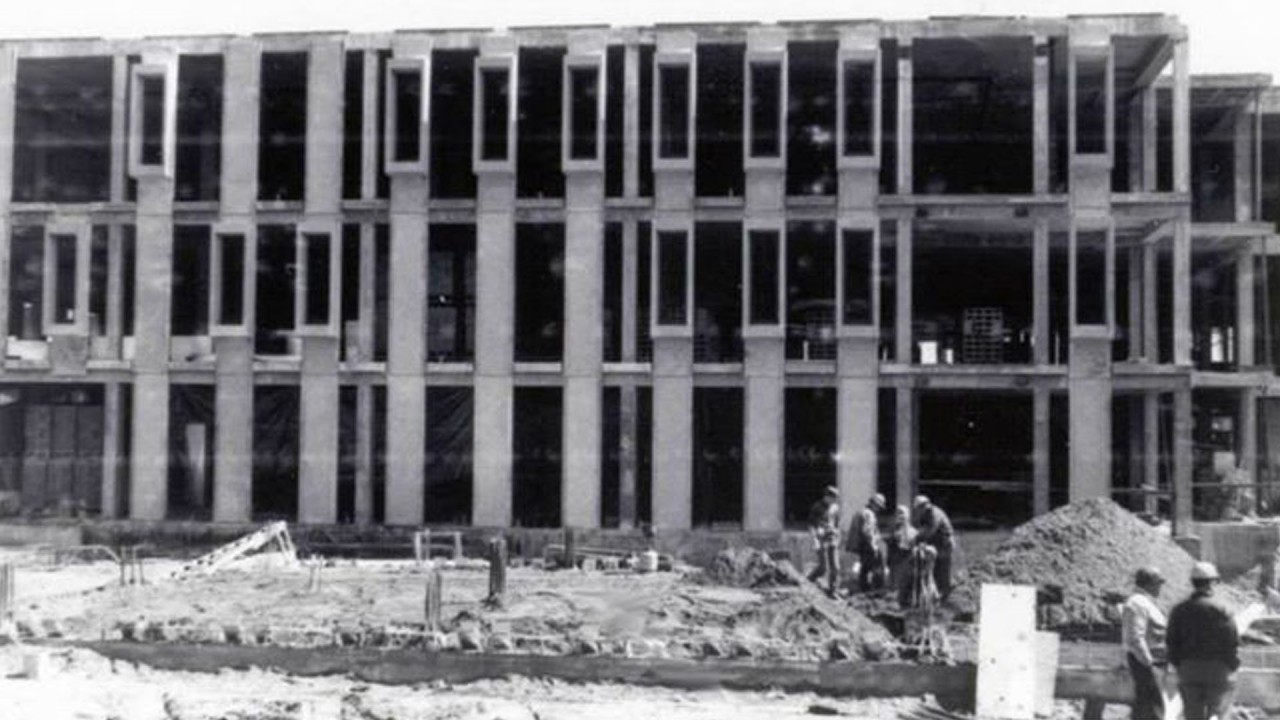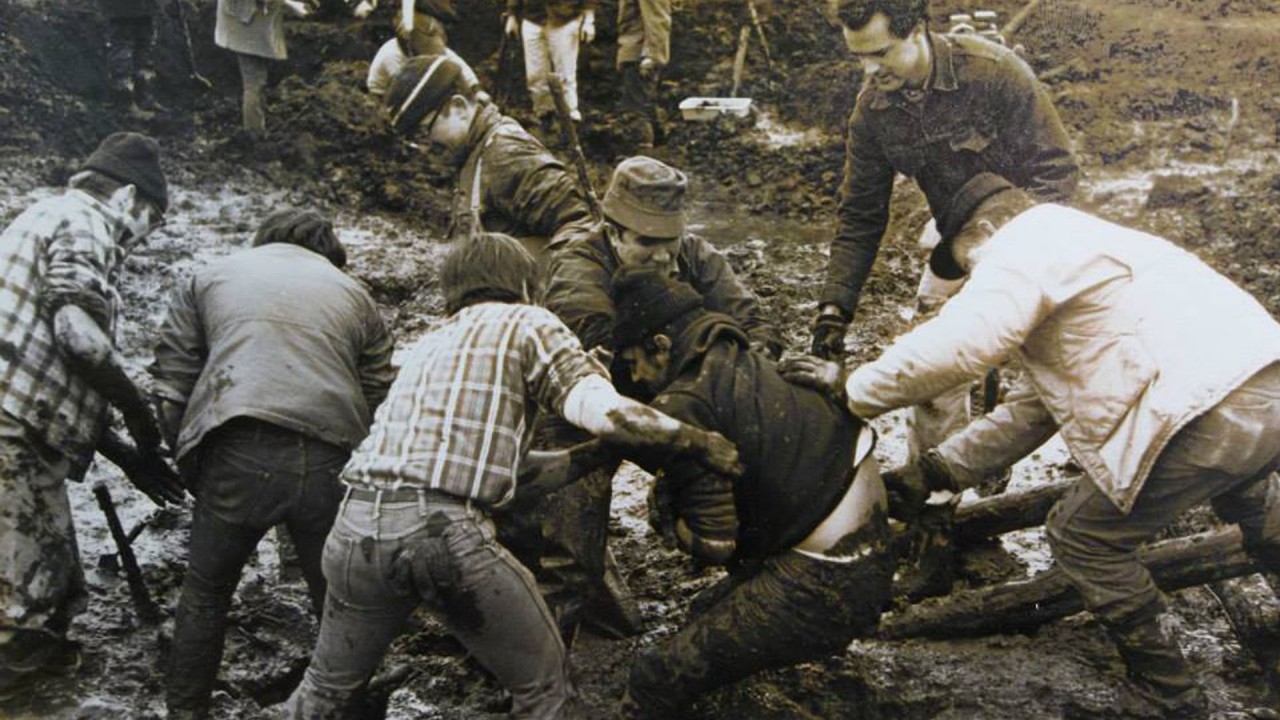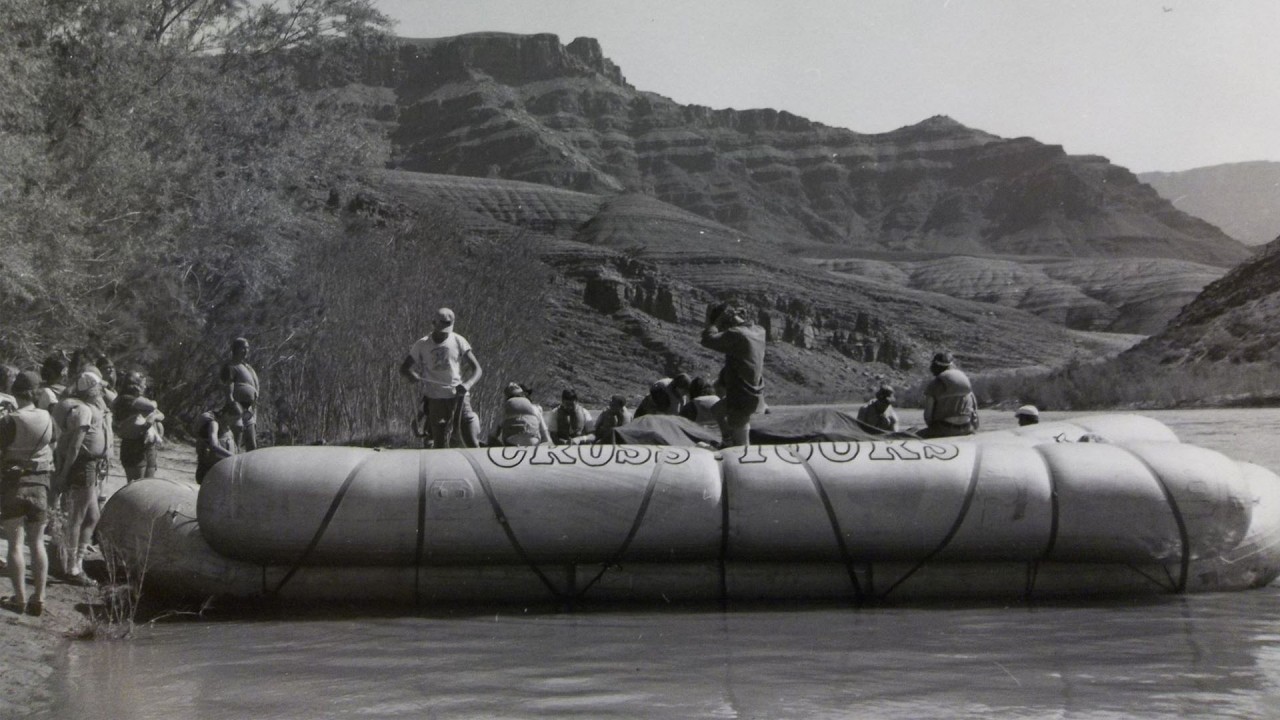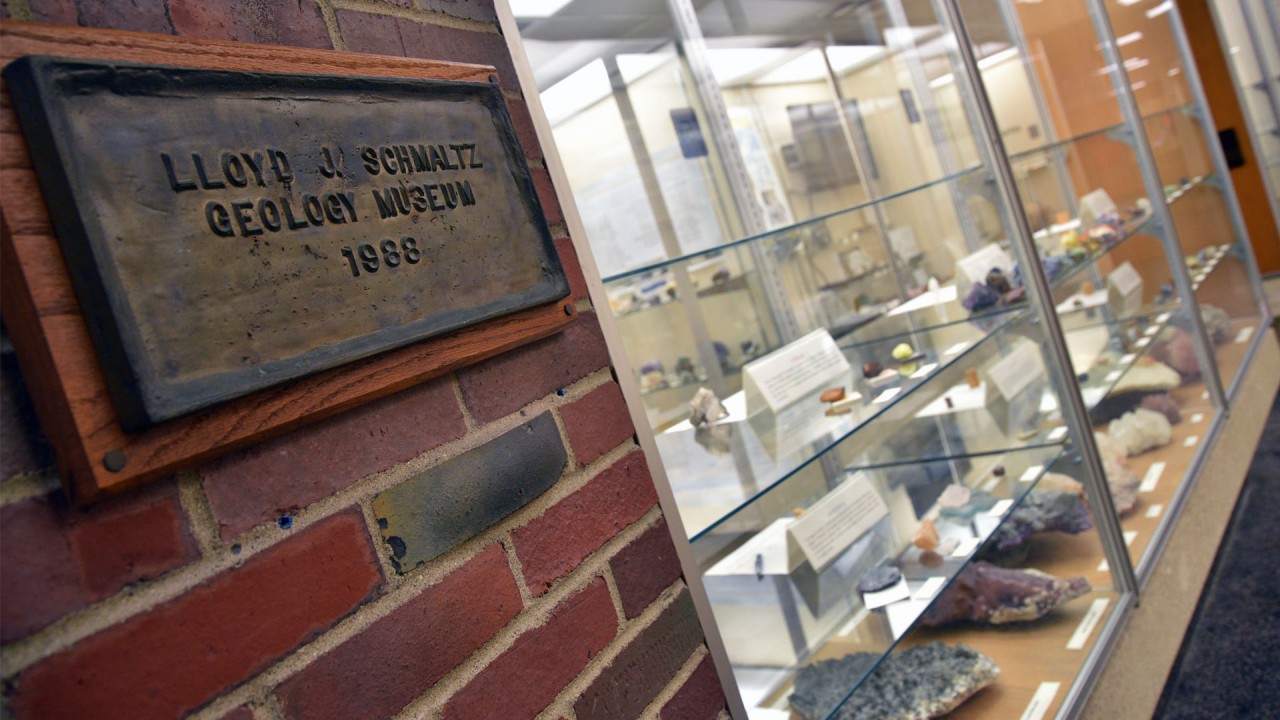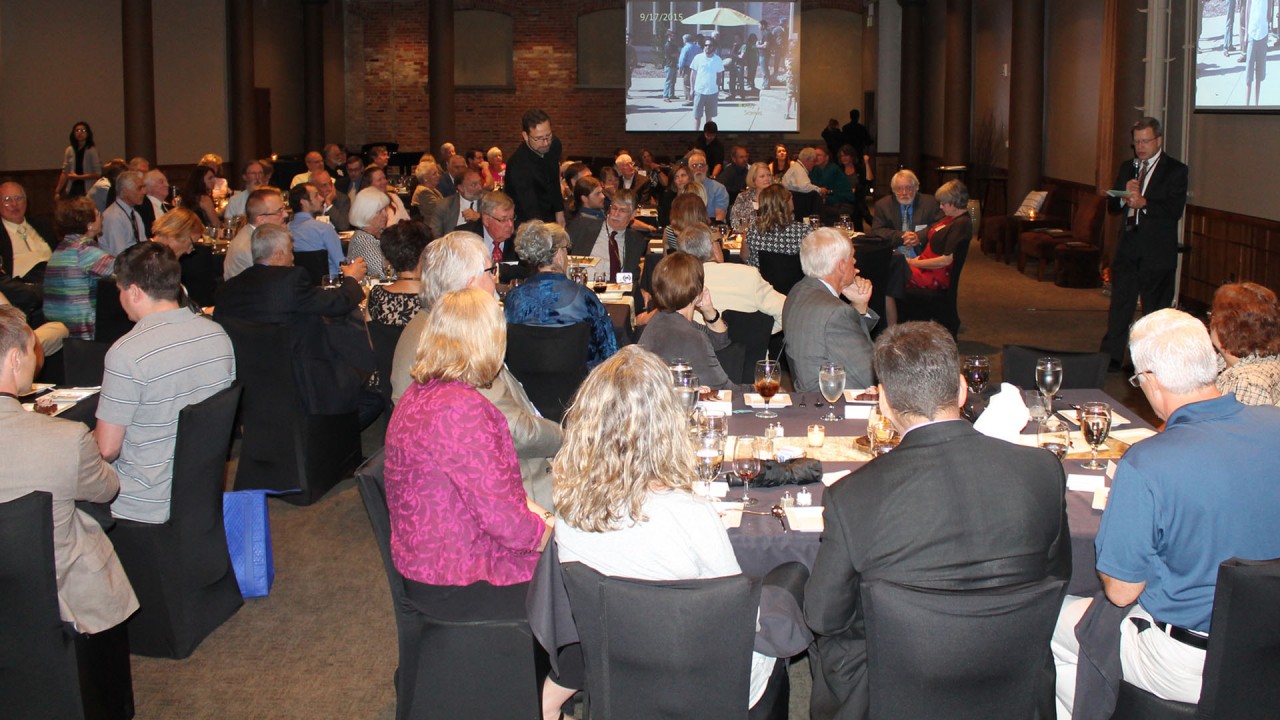The Department of Geological and Environmental Sciences at Western Michigan University has a long history of quality education, research and public service. These achievements have been made possible by our dedicated faculty, staff and students. We continue to grow with an unwavering commitment to succeed and by remembering our past. In 2015, our department celebrated its fiftieth anniversary. View the annual department photos from the 1970's to present.
Important events in the history of the department
1900 to 1940
As a subject, geology has been taught at WMU since the opening of the Normal School in 1904. The instructor of that course, which was called “Geographic Geology and Evolution of the North American Continent," was Leslie H. Wood, in whose honor Wood Hall is named. During the first few years, Wood was the only instructor in the Department of Geography and remained at the fledgling school for many years. In 1907, a course called “Minerals and Rocks” was added to the geography curriculum. By 1925, the geography department had grown to four faculty members, and its name had changed to the Department of Geography and Geology. There were three geology courses at that time: 207A-Geographic Geology, 207B-Economic Geology, and 207C-Historical Geology—another course that is still taught. Although the other faculty members occasionally taught a geology course from time to time, the vast majority of geology courses were taught by professor Wood. In the 1931-1932 academic year, a major transition in geology instruction began as Dr. William J. Berry arrived at the school and Leslie Wood retired at the end of the year. During his tenure, in which he served as chair of the department for many of those years, Berry was the only faculty member who taught geology courses on a regular basis. In the 1939-1940 academic year, Geography and Geology 335-Mineralogy, was introduced as a new course.
The 1940's and 1950's
In the 1946-47 academic year, the following geology courses were taught: 230A-Dynamic Geology, 230B-Historical Geology, 230C-General Geology, 332-Physiography of the United States, 335-Mineralogy and 350-Field Geology (summer trip). The last course was described as a field trip from Kalamazoo to the Black Hills region of South Dakota, with a course fee of $50. Although local field trips were common in many of the geology courses, this appears to be the first extended field trip taken out of the region. One of the faculty members in the department at the time, a geographer, was Dr. H. Thompson Straw, whose name is coincidentally very similar to a longtime member of the geology department, W. Thomas Straw, who arrived several decades later. In 1958-59, Dr. William J. Berry retired. The undergraduate geology major was founded within the combined departments of geography and geology. The modern era of the geology department began in 1959 with the hiring of Dr. Lloyd J. Schmaltz. At that time, the combined department was housed in the old Natural Science Building (West Hall) on East Campus. Dr. Schmaltz became the advisor for a new major in geology, which included courses such as: Physical Geology, Historical Geology, Invertebrate Paleontology, Mineralogy, Petrology and Structural Geology. Other courses offered included Introduction to Geology, Economic Geology and Geomorphology.
The 1960’s
In 1962, the department moved into the newly constructed Wood Hall. In 1963, the earth science major and minor was established within the combined departments of geography and geology. On July 1, 1965, the Department of Geography and Geology formally split into the Department of Geography and the Department of Geology. Dean George Mallinson was instrumental in this transition and also helped Dr. Schmaltz establish two very successful NSF funded summer institutes for high school earth science teachers. At the time of the new department’s inception, the faculty consisted of Drs. David Kuenzi, Richard McGhee and Richard (Skip) Davis, along with Dr. Schmaltz. Graduate programs began in the late 1960’s with a Master’s Degree in earth science education, which built upon the highly successful undergraduate earth science teaching program, that was headed by Dr. Passero. The Geology Club at WMU was established in 1965.
The 1970’s
Rood Hall, the new home of the Department of Geology, was constructed in 1970. Faculty growth thereafter was extremely rapid. By 1971, the faculty totaled seven, with three relatively new members: Drs. John Grace, Richard Passero and W. Thomas Straw, all of whom subsequently played major roles in the department for years to come, along with several others of shorter tenure. Soon after, a master’s in geology (1970-71) was initiated and the department’s research activities, which had always been strong, were brought to the forefront. Graduates found excellent employment opportunities in the petroleum and mining industries. The 1970’s was a decade of continued expansion in faculty and programs. One of the first research concentrations in the department was Rocky Mountain tectonics, which involved professors David Kuenzi, Ron Chase and new faculty member Chris Schmidt. This research program has been the recipient of many NSF grants over the years. In addition to Rocky Mountain research, sedimentologic studies by Dave Kuenzi in Guatemala and the Lake Michigan coastal erosion studies of Skip Davis with the US Army Corps of Engineers, were very successful for several years. Students and faculty worked together to unearth the remains of a mastodon in Van Buren County, MI in 1971, the remains of which are still housed in the Lloyd J. Schmaltz Geology and Mineral Museum in Rood Hall. Another new faculty member in the early 1970’s was Dr. William Harrison. Dr. Harrison arrived as a paleontologist but quickly developed an interest in the petroleum geology of the Michigan Basin. He established the Michigan Basin Core Research Laboratory, which gradually grew over the years to become a major resource to the Petroleum industry in Michigan.
During the 1970’s, two factors combined to drive a reevaluation of departmental programs and a major new focus of the department. These factors were a downturn in hiring in the always cyclical petroleum industry and a national de-emphasis on science education. In response, the department created a document entitled “A Master Plan for Development” in 1973 that outlined a far-reaching move into environmental geology, a subject that was becoming increasingly publicized at that time. Environmental crises such as the contamination at Love Canal were being discovered on a regular basis, and the contamination by waste disposal practices of groundwater, previously thought to be a pristine, naturally filtered resource, was beginning to be recognized as a major national issue. Although resources were not provided for implementation of many of the specific recommendations of the master plan, the overall emphasis on environmental geology would serve the department well for the next three decades. New research programs and degree concentrations developed under the environmental master plan spearheaded by Drs. Passero, Straw and Schmaltz, proved to be a groundbreaking approach that was eventually emulated by most geology departments in the country. Alumni of the department gathered with Dr. Schmaltz, dedicating a large piece of Greenstone outside Rood Hall during the “Jubilee” in 1975. The first annual departmental newsletter was written in 1975.
One of the goals of the environmental focus of the department was to provide geologic and hydrogeologic information for the local and regional areas. This goal led to the publication of “Kalamazoo County: Geology and the Environment” in 1978. In 1979, the department was awarded approximately $600,000 from the US Environmental Protection Agency to investigate the aquifers of Michigan in relation to underground injection of hazardous wastes. This project culminated in the publication of the “Hydrogeologic Atlas of Michigan,” which still serves as the most significant statewide reference on aquifers in Michigan. The atlas is still in high demand by consulting companies and agencies involved with the state’s groundwater resources. With the arrival of Dr. William Sauck in 1979, applied geophysics became one of the strengths of the department. The application of geophysics to environmental problems was a new research area in which Dr. Sauck and, later, Dr. Estella Atekwana, developed strong reputations. Dr. Sauck left the department to teach in Brazil but later returned, first as a researcher in the Institute for Water Sciences and then later back into the department.
The 1980's
In 1982, the Michigan Geological Repository for Research and Education was founded by Dr. William Harrison. MGRRE is an important entity for the Department of Geosciences and Western Michigan University. The facility continues the original Michigan Basin Core Research Laboratory's mission of geological research and technology transfer about Michigan subsurface geology, efficient recovery of fossil fuels and carbon dioxide sequestration. It also includes geological research and education about water resources and environmental topics. The department’s growing expertise in environmental geology and hydrogeology led to the awarding of a GEM (Groundwater Education in Michigan) Regional Center by the Kellogg Foundation, the development of the Institute for Water Sciences and a multi-year Research Excellence and Economic Development grant from the State of Michigan in 1985. In addition to funding a number of research projects, two new hydrogeology faculty members, Drs. Duane Hampton and Alan Kehew, were brought into the department. At about the same time, Dr. David Barnes arrived to bolster the department’s expertise in sedimentology. Dr. Lloyd Schmaltz retired in 1988 and was replaced as chair by Dr. Thomas Straw. In 1988 the department developed and taught its Hydrogeology Field Course, one of the very few hydro-technical programs in the United States, for the first time. The department’s excellent museum in Rood Hall, under the supervision of curator Robert Havira, was renamed the Lloyd J. Schmaltz museum in honor of his long service and significant contributions spanning the entire existence of the department. After retirement, Dr. Schmaltz continued to lead his highly popular raft trips down the Colorado River through the Grand Canyon for students, alumni and friends of the department.
The 1990’s
The department continued to evolve and change in many ways during the 1990’s. Dr. Estella Atekwana (geophysics) joined the department in 1990. A Ph.D. program in hydrogeology was introduced in 1990. Although small, the program has been very successful in placing graduates in academia and industry. Lake Michigan bluff erosion studies were undertaken in the 1990’s by Ron Chase and Alan Kehew and remained in progress during many years to come. New faculty replacing those who arrived in the 1960s and 1970s broadened the scope of the department and its teaching and research activities. These faculty included: Dr. R.V. Krishnamurthy (isotope geochemistry), Dr. Daniel Cassidy (bioremediation) and Dr. Michelle Kominz (geophysics). Dr. Alan Kehew became chair after the retirement of Dr. Straw in 1996 and remained in this position through the end of the millennium. A new name, the Department of Geosciences, was chosen in 1997 to reflect the broader, interdisciplinary approach to the earth sciences represented by these additions.
The 2000’s
Dr. Carla Koretsky (geochemistry) joined the department in 2000. In 2004, Dr. Mohamed Sultan came to WMU and established his well-funded earth science remote sensing laboratory in Wood Hall whilst assuming the role of Chairperson for the department.
The 2010’s
In 2011, the department took ownership of the Michigan Geological Survey; Dr. Alan Kehew was named interim director of the Survey. The survey facilitates research to promote the wise use of natural resources while serving the general public through quality research, invaluable expertise and historic data repository. The 47th Annual Meeting of GSA’s North Central Section was hosted by the Department of Geosciences at the Fetzer Center on the campus of Western Michigan University. Geoscientists from the north-central U.S. and beyond convened in Kalamazoo on May 2 to 3 to celebrate GSA's 125th Anniversary and discuss new science, expand on existing science and explore the unique geologic and historic features of the region, with a special emphasis on the Great Lakes. Effective October 2, 2013, our alumni and long-time WMU geosciences advisory council president, John Yellich, assumed the responsibilities as director of the Michigan Geological Survey. As director, Yellich supervises the activities of the Survey's various operational geological resource centers, which include: surface mapping, subsurface geology, energy, mineral resources, geologic hazards, research and education outreach and water resources. Emeritus professor, Dr. John Grace passed away surrounded by family on May 21, 2012. In 2012, three of our senior faculty members, Ron Chase, Mike Grammer and Carla Koretsky, retired or left for other positions on campus and off campus. Dr. Joyashish Thakurta was hired in 2013 to replace Dr. Ron Chase as our resident igneous and metamorphic petrologist. 2015 marked the fiftieth anniversary of the Department of Geosciences. This anniversary was celebrated with a weekend-long alumni event. In 2015 as the department celebrated it's 50th anniversary as a stand-alone unit on campus, a two-part series (Part 1 and Part 2) of commerative videos were created honoring it's legacy and long-time faculty members. In 2015, Dr. Chris Schmidt retired from his post as structural geologist. In 2015, the WMU student chapters of American Institute of Professional Geologists and the Society of Exploration Geophysicists were chartered. The student chapter of the American Association of Petroleum Geologists was also reestablished in 2015. Another new geosciences faculty member was hired in 2015, Dr. Stephen Kaczmarek. In 2016, two new programs were added to the department's offerings: the Certificate Program in hydrogeology and the Accelerated M.A. in earth sciences. A new faculty member was hired in 2016,Dr. Matt Reeves. After 30 years with the department, Dr. Dave Barnes retired in the spring of 2016. As our program has evolved over the past 53 years, we have expanded our emphasis on applied environmental and hydrogeological research, thus, the department changed it's name to the Department of Geological and Environmental Sciences in 2018. Dr. Mine Dogan joined the department in July of 2018. Dr. William Sauck retired in the spring of 2019. In 2020, Dr. Alan Kehew retired after many years of service and leadership to the department and Dr. Mohamed Sultan stepped down as chair. In July 2020, Dr. Heather Petcovic assumed the role of Department Chair.
Department photos from 1970 to present
For more throwback photos, visit the department's Facebook page.

